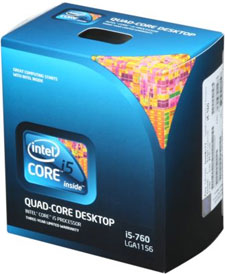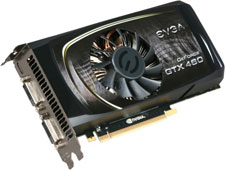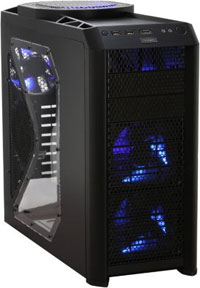Holiday 2010 System Builder's Guide
by AnandTech Staff, edited by Jarred Walton on November 19, 2010 2:00 AM EST- Posted in
- Guides
- Systems
- Holiday 2010
| Vivek's Midrange Intel System | ||
| Hardware | Component | Price |
| Processor |
Intel Core i5-760 Lynnfield 45nm (4x2.8GHz to 3.33GHz Turbo, 8MB L3, 95W) |
$200 |
| Motherboard | Gigabyte GA-P55-USB3 (Intel P55) | $120 |
| Video | EVGA GTX 460 768MB (768-P3-1360-TR) ($30 MIR) | $140 |
| Alternate GPU | ASUS GTX 460 768MB (ENGTX460 TOP)($20 MIR) | ($150) |
| Alternate GPU | ASUS Radeon HD 6850 1GB (EAH6850) | ($200) |
| Memory |
Corsair XMS3 2x2GB DDR3-1600 CL9 (CMX4GX3M2A1600C9) |
$65 |
| Hard Drive | WD Caviar Blue 1TB (WD10EALS) | $70 |
| Optical Drive | ASUS 24x DVDRW (DRW-24B1ST) | $20 |
| Power Supply | OCZ ModXStream Pro 700W (OCZ700MXSP) ($25 MIR) | $55 |
| Case | Antec Nine Hundred Two | $89 |
| Total System Price (Price based on GPU choice) | $759-$819 | |
When Jarred pitched his idea of a midrange gamer build, I liked the general idea except for one thing—the AMD processor. I'm more of an Intel guy at heart, so I tried to envision a similar midrange system built around an Intel platform. I built a very parallel system for personal use around this time last year, so I'll toss in a few anecdotes from my experience.

The processor was by far the easiest choice to make. At the price point we're looking at, the Core i5-760 makes the most sense. It's a quad-core Lynnfield running at 2.8GHz, with the only difference between it and the $280, 2.93GHz i7-860 being the clock speed bump and the lack of Hyper-Threading in the i5. Given that you've got four cores to work with, you won't miss the extra threading capabilities unless you're running some really highly threaded workloads. The 2.66GHz i5-750 is still kicking around at $199 (I can't believe that Intel has kept it at exactly the same price it was a year ago when I bought one!), but you can find the 760 for the same price. I figure it's not worth the $80 bump to the i7 line, as that money is better spent elsewhere.
For the motherboard, I went with the Gigabyte GA-P55-USB3. It's a rock solid board with USB 3.0 and a second PCI-E slot for CrossFireX support. In a mid-priced motherboard, there's not too much else you can ask for (except for maybe IEEE 1394). The Gigabyte P55 line has been popular since the launch of Lynnfield, and based on my experience I have no problems recommending it. As with Jarred's build, if you're serious about CrossFire you'll probably want to go with a different board that can do x8/x8 to the GPUs; as luck would have it, Biostar's T5 XE CFX-SLI has dual x8 slots and tosses in SLI support (via a PLX chip), and depending on the vendor it's even cheaper than the Gigabyte offering. Is it as reliable and does it have great support should something go wrong? We haven't had any serious issues with Biostar, but they can be a bit hit-or-miss.
RAM is kind of dependant on how much you need—I went with 4GB in my build last year and haven't felt short of memory, but I'm adding more this Black Friday just in case. For this build, I went with a Corsair XMS3 4GB (2x2GB) kit of DDR3-1600. Corsair's XMS3 was one of the more reasonably priced RAM kits on Newegg, but you can really go for whatever you feel comfortable with. I know a lot of people who like the G-Skill Ripjaws line, but they're rather pricey especially if you go for the 7-8-7-24 timings ($88 versus $75 for the 9-9-9-24 Ripjaws, and $65 for the XMS3s that also run at 9-9-9-24). Unless you have a specific preference for brand, you're probably better off going for whoever has the best sale.
Hard drives are another place where once you determine the capacity and speed, you're not going to get a whole lot of performance variation between different brands. I know people that swear by Seagate, I know some that swear by Western Digital, I know a lot that swear they hate either (or both), and there's Anand, who swears against hard drives on principle. In all honesty, I don't care either way, so I specced this system with the WD Caviar Blue 1TB 7200RPM drive, which at $69 is not a bad buy. There are 1TB drives from Seagate, Samsung, and Hitachi at the same price, so you're not at a loss for choice.

The graphics card is where things get interesting. If you're a serious gamer, I figure the lowest you want to go is the NVIDIA GTX 460 768MB. Most of those are going for $169, but the bog-standard EVGA GTX 460 listed above has a $30 rebate on top of that, and the more customized (and mildly factory-overclocked) ASUS ENGTX 460 comes with a $20 MIR. So if you don't mind the MIR, you can get away with a "low-end" GTX 460 for $140-150. Given the overclocking potential inherent to the GTX 460, that's a pretty good price.
But what if you want something faster? The best place to look is the HD 6850 (the 6870, at $240-300, is a bit too expensive for a midrange build). Ryan really liked the ASUS EAH6850 when he looked at the XFX, MSI, and ASUS retail HD 6850 cards earlier this month, and so it makes another appearance here. At $200, it's competitively priced against the rest of the HD 6850 partner cards, and it makes a good tradeoff between temperatures and noise. Like the ASUS ENGTX 460, it comes with a token overclock and ASUS' highly effective Direct CU cooler. It's faster than the comparably priced 1GB GTX 460 cards, so it's a worthwhile upgrade to make if you'll make use of the extra graphics horsepower on hand.
Of course, now you have to decide if you're at all interested in adding a second GPU in the future; if so, you should note that most budget P55 boards only support CrossFireX. For those going the AMD route, the specced Gigabyte board will be fine, but if you're after SLI support, the Biostar T5 XE CFX-SLI has what you need for $15 more than the GA-P55, with an epic, highlighter-esque colour scheme thrown in just for kicks.
For the power supply, I went with the OCZ ModXStream 700W. This is what I ended up buying for my build last year, and I’ve had no problems with it. There's usually a good sale on it somewhere; I picked it up for $49 last year (after a $35 rebate) and it’s currently going for $55 after a $25 rebate. I know that the Corsair line of PSUs is very popular, but they’re significantly pricier than the OCZ, as are the Antec PSUs (unless you get a combo deal on one with a case like in Jarred’s build). Generally speaking, most of the 80 Plus certified PSUs will work well; some are still better than others, but the difference between 82% and 87% efficiency isn't all that great and the price often climbs rapidly once you move beyond the Bronze level. The OCZ is a standard 80 Plus model at a good price, but if you're looking for other options the Seasonic S12II 520W is Bronze certified, well reviewed, and costs just $10 more than the OCZ.

Case choices are very personal; I prefer flowing and elegant cases, like the old Cooler Master WaveMaster and the Thermaltake Tsunami, which is what I got for my own system. I abhor the design of the wildly popular Antec Nine Hundred—something about the weirdly pentagonal side just doesn’t sit right with me, though I must admit that it is a very high quality case. The Nine Hundred Two on the other hand has a more rectangular design that suits my taste much better, but at $90 it’s not the cheapest case on the block. Jarred specced his build with the Antec Three Hundred, which is a bit smaller and a bit cheaper, but get what you like.
So how does this stack up against Jarred's build? It has a more expensive case, PSU, motherboard, and processor with a slightly slower GPU (assuming you get the standard GTX 460 768MB), but then the i5-760 will generally outperform Phenom II 965. As configured and with the mail-in rebate for the GTX 460 and PSU, the net difference is only around $30, but if we just look at the motherboard and processor the "Intel tax" is about $50 (or about 7% looking at the entire system). Whichever GPU and system you choose, both of our midrange builds will handle just about any task you might throw their way—including gaming.










112 Comments
View All Comments
JarredWalton - Friday, November 19, 2010 - link
While it would be great if Bulldozer could run in current motherboards, all the information I've been able to gather (including asking a contact at a motherboard manufacturer) is that Bulldozer for desktops will run in AM3r2. That socket will be similar to AM3, and it will be able to accept and run current AM3 processors, but the reverse isn't true. So, in essence it's the AM2+ situation again.If you search AMD's site, there's no mention of AM3r2 that I can find outside of their forums. It's still possible that we're mistaken, but AMD hasn't unequivocally stated that "yes BD will work in current motherboards" so I wouldn't count on it. I think originally the idea was to try and make it happen, but now it's not guaranteed.
If you really want to go to the rumor mill, BD might actually work in current boards but might blow caps or have reduced performance. Maybe someone will come out with a fix. All indications however are that there will be new chipsets (980/990 most likely), a new socket requirements, etc. I guess it may be a lot like the socket 775 transitions from Intel where we had a few manufacturers that got older 945P chipsets to run Core 2 and such.
JarredWalton - Friday, November 19, 2010 - link
Just to add a bit more: Phenom X6 will technically work in many 790FX motherboards... but it's not the same as running it in an 890FX. 790FX wasn't designed for Turbo Core, it has some power management issues with Thuban, etc. We have seen similar issues with previous updates where a CPU would work, but it didn't perform optimally. We may see that with Bulldozer as well, where it will run in 800 series boards with a BIOS update but it very likely will run best with a new motherboard/chipset. If AMD and their partners can prove me wrong, I'd be very pleased, but based on at least one source I'm not holding out much hope.blotto5 - Saturday, November 20, 2010 - link
thanks for the info good to know since im running a phenom x6 in a 790fx mobo but i think im going to wait to buy a new mobo because of this talk of a new socket a la am2 to am2+baba264 - Friday, November 19, 2010 - link
This comes quite handy as after the death of my graphic card two days ago, I was seriously thinking of buying a new system that would be quite similar to "Ryan's High-End Gaming System".However, when I had previewed the various parts I wanted, I had set my mind on a new lynnfield core with an i7 870 rather than the old Bloomfield core. Since I don't plan to upgrade to an SLI setting I thought that the i7 870 was the best choice of processor (for the price), was I mistaken?
Anyway, thanks for the article, this article really comforts me in what I meant to buy.
Ryan Smith - Friday, November 19, 2010 - link
The 870 is quite good. In fact when I was putting that list together I was seriously considering that instead of an X58 platform. The clincher was SLI support (P55 boards with SLI quickly drive the price up); but since you're not going to be using SLI I wouldn't be concerned.mapesdhs - Friday, November 19, 2010 - link
P55 boards run very nicely SLI, easily outperforming X58 boards, and that's
with an 860, never mind an 870. See my results pages:
http://www.sgidepot.co.uk/misc/pctests.html
http://www.sgidepot.co.uk/misc/stalkercopbench.txt
Further tests coming soon with an 870 + GTX 460 FTW SLI.
it's only really 3-way SLI where X58 takes over. For 2-way, the speeds
are just as good (if not better) and the costs are significantly lower - the
board I'm using costs less than 70 UKP ($110).
Ian.
JarredWalton - Friday, November 19, 2010 - link
Color me confused, but those links don't seem to provide the data you're talking about. The question is how something like i7-930 with X58 compares to i7-860 with P55 while everything else is kept constant, and all the stuff there looks like 930 + 4870 CF or 460 SLI, and 860 + 8800 GT SLI, or some other sets of data. You'd need to show X58 460 SLI vs. P55 460 SLI to "prove" that P55 is "easily outperforming X58 boards". And if you do everything with similar quality components, the X58 ought to win out by virtue of having two x16 connects compared to two x8 connects on P55.mapesdhs - Friday, November 19, 2010 - link
(my friend has 4890s, not 4870s)
I'm surprised you'd say that given existing articles have already
shown that SLI doesn't need full 16x to perform nicely. Some games
need it because they're written badly (FSX), but others run perfectly
well at 8X, or even 4X.
Specific data coming soon (still testing) but my point was that the
existing data already shows the same effect - people on forums
said the 4890s should win, but they don't much of the time except
where resolution, etc. are a factor.
I'm still ploughing through my P55/460 tests. All takes time as I'm
sure you can appreciate. :)
Ian.
JarredWalton - Friday, November 19, 2010 - link
I'm not saying X58 is substantially faster by any means; I'm just saying that all things being equal there's no reason P55 should be faster. x8 vs. x16 isn't a huge benefit, but especially with higher clocked CPUs and more powerful GPUs (i.e. GTX 580 or HD 5870) the X58 should come out ahead. Anyway, Gary Key did a pretty direct comparison when he was still with us:http://www.anandtech.com/show/2847
In general X58 CF is better than P55 CF, though the margin is never so large as to be alarming. What Gary doesn't show is how the SLI setups compare (probably for lack of an SLI capable P55 board at the time he was with us). I'd figure they're also similar. All told, P55 is faster for single GPUs, but the x8+x8 dual-GPU configuration should and usually does incur a small performance hit.
mapesdhs - Saturday, November 20, 2010 - link
Generally true, though remember the one advantage which
can make a difference sometimes (and push it in favour
of P55) is the better Turbo on the 870, etc. For fixed
clocks, have a look at the CPU scores I get with the
860 at 4018 for the 3DMark06 CPU tests, compare to
my friend's 930 at 4136 (and btw, it's not RAM speed;
I lowered my RAM to match, scores only dropped 1
or 2%).
You're right though about the top-end cards/CPUs, if
I was playing at crazy res with expensive cards like
the 580 then X58 would be more logical. For midrange
though, like the 460 (with or without SLI), the gain from
X58 is minimal at best - the cost difference (which
may be large) can be used to have a better GPU,
widening the gap further.
And by cost difference I mean, for example, the Asrock
P55 Deluxe, which is now as cheap as 68 UKP here.
It has excellent slot spacing for SLI, ie. better cooling.
Either way, we shall see; after doing default tests, my
plan is to run the FTWs at lower clocks to match my
friend's Palit Platinums, that should be interesting.
All I'm saying is, don't be surprised if P55/SLI runs
better than you might expect. I certainly didn't think
two 8800GT SLI would be able to match or beat
an X58 with two 4890s, but they can and do.
Ian.